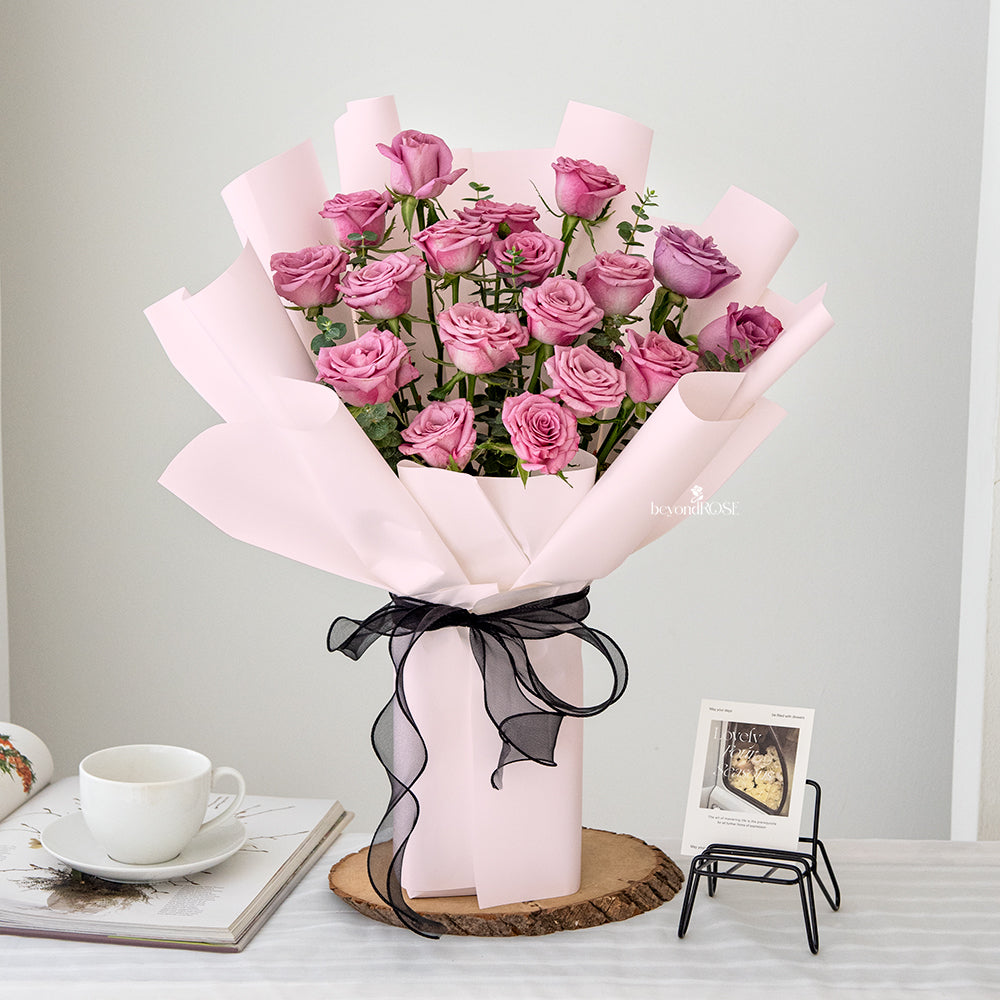
The Timeless History of Roses: From Ancient Persia to Modern Romance
Share
Why Roses Captivate Us?
Few flowers have captured the human imagination like the rose. With fossil records dating back over 35 million years, roses have journeyed from wild mountain slopes to royal gardens, and from sacred temples to Instagrammable bouquets in downtown Kuala Lumpur and Orchard Road. Whether it's a Valentine's Day bouquet in Malaysia or a 520 Day surprise in Singapore, the rose continues to symbolise deep emotions from love and desire to purity and remembrance.
But what makes the rose so enduring? Is it the velvety petals, the intoxicating fragrance, or its timeless connection to human culture? Let’s travel through time and space to discover how this beloved bloom became the world’s floral monarch.
1. Ancient Beginnings: Where Roses First Bloomed
Fossil Evidence: 35 Million Years of Natural Beauty
Roses are among the oldest flowering plants on Earth. Fossils of ancient roses have been unearthed in places like Colorado, Germany, and Central Asia, indicating their prehistoric roots. These wild roses were far simpler than the hybrids we adore today—typically five-petaled and thorny but no less captivating.
Persia: The Cradle of Rose Cultivation
Around 5,000 years ago, in what is now Iran, roses were first domesticated and admired not just for their beauty but also for their aromatic oils. The famed Garden of Cyrus the Great—legendary ruler of the Persian Empire—was said to contain exquisite rose species. Persian poets and mystics, like Rumi, often used roses as metaphors for divine beauty and spiritual longing.
With the expansion of trade along the Silk Road, roses were carried eastward to China and westward into Europe, spreading their charm across continents.
2. Roses in Classical Civilisations
Egypt: Cleopatra’s Floral Obsession
Cleopatra, known for her dramatic flair, reportedly filled her palace chambers knee-deep with rose petals to seduce Mark Antony. Roses were used not only in romance but also in skincare and religious rituals. Ancient Egyptian tombs even contained rose remains, signifying their value in the afterlife.
Greece & Rome: Myths, Gods, and Glamour
In Greek mythology, the rose was born from the tears of Aphrodite, the goddess of love. The Romans adopted this symbolism, associating roses with Venus, her Roman counterpart. Roses were considered a symbol of luxury and status. Emperor Nero famously spent the equivalent of over $200,000 in today’s money on rose petals for a single banquet.
3. Medieval Roses: From Monks to Monarchs
Monastic Medicine and Marian Symbolism
During the medieval period, roses were cultivated in monastery gardens. Monks used rosehips to make vitamin-rich remedies, especially during times when scurvy was common. The rose also took on strong religious symbolism, particularly the white rose, which was linked to the Virgin Mary and frequently appeared in illuminated manuscripts and church art.
The Wars of the Roses (1455–1487)
This brutal English civil war was famously represented by two floral emblems: the white rose of the House of York and the red rose of the House of Lancaster. The war ended with the marriage of Henry VII to Elizabeth of York, symbolised by the creation of the Tudor Rose, a merged emblem of unity.
4. Asia's Golden Age of Roses
| Country | Contribution | Modern Impact |
| China | Developed early grafting techniques | Gave rise to Hybrid Tea Roses |
| Japan | Ikebana (flower arrangement art) | Influenced minimalist floristry globally |
| Malaysia | Cultivated tropical rose hybrids | Created heat-resistant varieties for ASEAN climates |
China: Birthplace of Innovation
As early as the Han Dynasty, Chinese horticulturists practiced grafting, which allowed them to create more diverse and beautiful rose varieties. Some of these early roses were later exported to Europe, forever changing Western floriculture.
Japan: Where Art Meets Nature
In Japan, roses found a place in the refined practice of Ikebana. Unlike Western floral arrangements, which emphasise abundance, Ikebana uses minimalism to express seasonal themes and spiritual balance.
Malaysia: Adapting Roses for the Tropics
Although roses are traditionally temperate plants, Malaysian horticulturists have successfully bred varieties that thrive in hot, humid conditions. From Cameron Highlands nurseries to boutique florists in Kuala Lumpur, Malaysian-grown roses are now vibrant, long-lasting, and locally celebrated.
If you want to find out what's the best gifts to give to your love ones with your roses in Malaysia, you might check this out: The Ultimate Malaysian Gift Guide to Make Roses Extra Special
5. European Rose Renaissance
Empress Josephine’s Garden: The Birthplace of Modern Roses
Napoleon’s first wife, Josephine, had a deep affection for roses. She assembled the largest collection of roses in Europe at her Château de Malmaison. Her passion inspired the development of the first hybrid perpetual roses, which combined the fragrance of old roses with the repeat blooming of newer varieties.
Victorian Language of Flowers
In the 19th century, Victorians used flowers to express emotions they couldn’t say aloud. Roses played a central role:
- Red: Love and passion
- Yellow: Friendship (Caution: not ideal for romantic gestures in Malaysian culture!)
- Pink: Gratitude or admiration
- White: Purity and new beginnings
- Black: Rebirth or mystery—not death, as commonly misunderstood!
6. Modern Roses: Science Meets Beauty
Breakthrough Varieties
- Hybrid Tea Roses: Long-stemmed and elegant, these are the florist’s favourite for romantic gestures—especially in urban areas like Kuala Lumpur and Singapore.
- Knock Out Roses: These low-maintenance, disease-resistant bushes are perfect for tropical home gardens.
- Rainbow Roses: These eye-catching, multi-coloured blooms are specially dyed and perfect for bold, Instagram-worthy gifts.
Growing Tips for Malaysia and Singapore
Roses in tropical climates require special care:
- Soil: Use a well-draining mix with organic compost.
- Sun: Ensure at least 6 hours of sunlight daily.
- Best Varieties: Look for climbing roses or miniature types adapted for humid weather.
7. Roses in Modern Love: From 520 to Valentine's
Singapore and Malaysia: Two Nations, One Love for Roses
In Singapore, roses are a must-have on 520 Day (May 20)—a Mandarin homophone for “I love you.” Meanwhile, Malaysians embrace them for birthdays, engagements, and even Raya celebrations.
Roses today are more than just flowers. They’re digital emojis, printed on skincare labels, and even infused in teas. Whether you’re shopping for your mum, your soulmate, or your secret crush, roses say it all—without saying a word.
Popular Phrases for Florist Captions:
- “Say it with roses.”
- “Every bouquet tells a story.”
- “From our Malaysian garden to your heart.”
- “Singapore’s freshest blooms—delivered daily.”
Conclusion: Why Roses Still Rule
From ancient Persian gardens to modern-day florist shops in Malaysia and Singapore, the rose has stood the test of time. Its petals have witnessed royal love stories, religious devotion, and scientific breakthroughs. It has survived wars, inspired art, and even sparked hashtags.
At beyondROSE, we are proud to be a part of this timeless tradition. Whether you're sending a heartfelt bouquet or planning a dreamy Valentine’s surprise, our carefully curated roses speak the language of love fluently.
